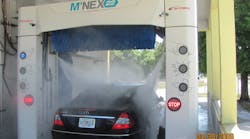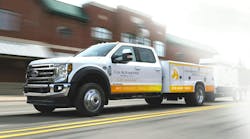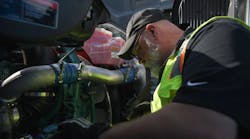Vehicles are operated in some rather harsh environments and are subjected to a continual bombardment of dirt and grit, acid from bugs and bird droppings and potentially abrasive and corrosive elements. Over time, these contaminants can chemically etch a vehicle’s surface, leaving permanent damage, which could ultimately lead to rust and corrosion.
Temperature accelerates the problem. Metal retains heat when sitting out in the sun, thereby increasing the chances that these “irritants” will cause permanent stains when left on a vehicle.
Along with keeping a vehicle looking good, regular washings help protect a vehicle’s finish. Plus, a clean vehicle is easier to perform maintenance and service on.
Maintaining clean vehicles also enhances a company’s public image.
There are a number of options for washing vehicles. Two of them are automated vehicle washing systems and pressure washers.
PRESSURE WASHERS
Commercial and industrial pressure washers come in a wide range of types and models to suit different needs and applications. So, how do you make sure you get the right pressure washer for your cleaning job?
Asking three basic questions will ensure that the right choice, says Rick Dunn, vice president, sales and marketing with Kärcher Commercial, a world leader in cleaning equipment and the premier brand of hot and cold water pressure washers in North America. They are: 1. What are you cleaning? 2. Where are you cleaning? 3. How long will you be cleaning?
CLEANING JOB
There are two categories of pressure washers: hot and cold water. Some pressure washers are available with a “steam combination” option where the hot-water flow is restricted in order to create a “wet steam” effect.
Pressure washers come in portable, skid-mounted, stationary cabinet and trailer-mounted systems for on-site cleaning.
“If you’re cleaning engines, automotive parts or anything else with oil or grease, your best option is a pressure washer that generates hot water,” Dunn advises. “Like the dishes in your sink, hot water cuts grease and grime; cold water only pushes it around.
“While there are a few applications - such as detailing an automobile engine - that require steam, it has been proven over the years that hot water under pressure is a much more effective method of cleaning.”
For simply blasting away soil, caked-on mud or even stripping paint, a cold-water pressure washer will work just fine, he says. “A cold-water pressure washer with the right detergent often can solve most cleaning problems.”
CLEANING LOCATION
Where you are doing the pressure washing is a factor. Washing indoors or outdoors can make a big difference in cleaning options, many of which “can dramatically impact your wallet,” says Dunn.
Other considerations are portability and power source.
“If you’re cleaning indoors, you’re limited on your energy sources,” he observes. “For instance, indoors you’re confined to using an electric motor to drive the high-pressure pump. The electric motor limits your portability because you’re constantly tethered to an electrical outlet.”
If hot water is needed indoors, you’re further restricted to the type of heating fuel you can use because of fumes from fossil fuels, he adds. Choices are electricity, natural gas or liquid propane (LP) - which require hard plumbing and must be vented to the outdoors.
For cleaning outdoors, there are pressure washers powered by electricity, gasoline or diesel. Typically, the electric-powered models are more economical, but the gasoline-powered pressure washers are a lot more portable because there is no electric cord.
“For outdoor cleaning with hot water, you can heat the water with diesel - the most popular - kerosene or fuel oil, in addition to the indoor energy sources of electricity, natural gas and LP gas,” says Dunn. Portable electric-powered and diesel-heated models continue to be the most popular hot water models for most customers that only need limited mobility.
“Portable hot water pressure washers with gasoline or diesel engines and heated by diesel are the choice for customers that need the ability to clean where water is readily available but electric power is not. These units are portable and self-contained and give the operator the ability to clean practically anywhere.”
For contract cleaners or customers that need to clean where water and power aren’t readily available, skid-style machines are available. Skids are self-contained units consisting of a gasoline or diesel engine, a belt-drive pump and heating coil.
Skids can easily be mounted to a trailer, box truck, van or other capable vehicle and can be plumbed to a large water tank (typically 200 to 500 gallons) for truly portable, on-site cleaning.
CLEANING DURATION
The question, how long will you be cleaning, “reaches the heart of how much quality you need in your pressure washer, which also affects the price tag,” Dunn says.
Most pressure washers, regardless of brand, have similar components. They have an engine or motor that turns a high-pressure pump. Hot-water models also have a burner that heats the water as it races through a coil made of pipe or tubing.
“The quality differences are not always obvious, but significant nonetheless,” he points out, and suggests asking seven insightful questions in order to identify quality in a pressure washer.
1. Is it belt-drive or direct-drive?
A high-pressure pump does not turn on its own, explains Dunn. It is driven by an engine or motor.
There are two predominant ways to connect the pump to an engine or motor: directly (direct-drive) or with a pulley and belt (belt-drive). Pumps generally turn at 1,100 to 3,600 rpm. Gasoline engines turn at a rate of 3,000 to 3,600 rpm. Electric motors turn at a rate of 1,450 to 3,450 rpm.
“Direct-drive pumps are more compact and more efficient since the pump is coupled directly to the motor or engine, so you can get more performance for the same input power,” he says. “Additionally, these units generally weigh and cost less.
“As you may expect, a pump turning at 3,600 rpm will wear out faster than a pump that turns at 1,500 rpm.
“On the other hand, a belt-drive pump, configured with a pulley and belt, allows the pump to turn at the slower rate - usually 1,500 rpm. The belt also dissipates the build up of heat and absorbs vibration from the engine.”
“The ultimate benefit,” notes Dunn, “is that downtime is minimized and the pump’s life is extended, saving money in the long run.”
2. What is the style of pump?
High-pressure pumps come in two major types: axial (sometimes called “wobble plate” or “swash plate” pumps) and crankcase pumps, he says. Axial pumps are only available in a direct-drive configuration, but have half as many moving parts as their crankcase pump counterparts.
Axial pumps work by the motor or engine turning a tapered plate inside the pump which directly moves the pistons of the pump to move the water produce pressure and flow. “Axial pumps can typically only achieve up to 5 gpm (gallons per minute) or 4,000 psi, but they are more efficient due to having fewer moving parts than crankcase pumps,” he points out. “Having fewer components in the pump means that there are fewer chances for an item to fail.
“One additional benefit to axial pumps is that due to having less items to move, you can achieve greater output performance than a crankcase pump with the same input power.”
Crankcase pumps are available in direct and belt-drive configurations and utilize a crankshaft, connecting rods and ceramic plungers.
Both styles of pumps come in various quality levels depending on price range.
3. Does it have high pressure or high volume?
“A little known secret is that there is more cleaning power in a pressure washer’s volume - gpm - than in its pressure - psi, says Dunn.
“A pressure washer with 2 gpm and 3,000 psi won’t clean as fast as a pressure washer with 4 gpm and 2,000 psi. The first pressure washer delivers 6,000 cleaning units (2 x 3,000) as compared to the second pressure washer’s 8,000 cleaning units (4 x 2,000).
“Volume is the deciding factor and a quality pressure washer will provide the proper balance of volume and pressure.”
4. Is the engine or motor size correct?
According to Dunn, many pressure washer companies advertise their units’ performance based on the maximum performance of the high-pressure pump coupled to the engine or motor. “While this may be the easy thing to do it is more often than not the wrong thing to do.”
For example, some companies advertise that their units will produce 4 gpm at 4,000 psi with a small compact frame and direct-drive pump and a 12-horsepower gas engine. But how can a consumer know if the unit will actually provide the advertised performance?
There are a couple of easy equations that can be used to see if the manufacturer is being honest about the unit’s performance, he says.
For a gas and diesel engine units:
|
gpm x psi |
x 1.3 |
|
1460 |
For electric motor units:
|
gpm x psi |
|
|
1460 |
If the unit has a generator, add 1.5 to 2 to the result. If the unit has an axial pump, deduct 0.5 from the result.
In the example: 4.0 gpm times 4,000 psi equals 16,000 divided by 1,460 and then multiply by 1.3 equals 14.2. This is the net horsepower required by a gas or diesel engine to power a crankcase pump and achieve the advertised performance.
“The net horsepower of the engine in question is 12 so the unit can either produce the advertised gpm or the advertised pressure, but not both at the same time” says Dunn. “Engine net horsepowers are available from the local pressure washer dealer or from the engine manufacturer.”
5. Are the accessories durable and comfortable to use?
Sometimes the purchaser of the pressure washer puts all of their focus on the unit without any consideration for the accessories that also come with the unit, says Dunn. Simple things like an ergonomically designed trigger gun, kink-free hoses and easy-to-change high pressure nozzles can make the difference between a terrible cleaning experience and an enjoyable one.
“A lot of thought should be given to the operator when making a purchase decision,” he recommends. “Using uncomfortable or unwieldy accessories can fatigue the operator or even lead to work place injury.”
6. Is it safety and quality certified?
UL-1776 is a regulation that describes in detail a variety of features that pressure washers should have to avoid injury. These include: safety relief valve, hose guard for burst protection, warning labels, ground fault circuit interrupter, high pressure release value and specified lengths for the wand and electrical cord.
“Make sure the certifying agency is a Nationally Recognized Testing Laboratory (NRTL),” stresses Dunn. Performance certification is also very important.
“The Cleaning Equipment Trade Association (CETA) gives manufacturers a stiff set of guidelines to build equipment to. CETA requires that the actual performance of the machine not vary by more than 5 percent of its actual performance. Typical consumer-duty units are not performance certified and the performance can vary by up to 20 percent.”
7. Is it backed by a solid warranty?
Quality pressure washers will have a minimum of a 5-year warranty on the pump and frame and a 3-year warranty on the gasoline engine, he says.
Another important question to ask is: How many trained, warranty service centers are there and is one close by.
“Despite their simplistic design, be assured that not all pressure washers are created equal,” he concludes. “Nonetheless, you can have confidence in making the right choice when you ask the right questions.”
WASHING SYSTEMS
For some maintenance and fleet operations, it might make sense to install a vehicle washing system, says Marc Tyndale, a partner of Car Wash Systems. Based in, Harrisburg, PA, Car Wash Systems provides consulting, design support, fulfills equipment needs and offers service and supplies associated with automated or manual vehicle wash equipment.
When considering a vehicle washing system, Tyndale says an operation should ask itself the following questions when deciding at what point automated washing versus manual washing makes sense, and what type of wash facility would best suit its needs.
1. How many passenger vehicles (cars, pickups and passenger vans) will be washed in a day, week or year?
“It is essential to know how many vehicles get washed daily for many reasons,” he stresses. “Fleets shrink and grow so it is imperative to plan for the future.”
For instance, some fleets cannot wash any more cars in a given day and need to utilize overtime if the demand is heavy. “Overtime is an overhead killer and raises the cost per vehicle considerably.”
2. How many large vehicles (sprinters, commercial trucks, construction equipment and buses) will be washed in a day, week or year?
“Large vehicles can add a new dimension to the paradigm of decision making,” notes Tyndale. “Large vehicles have different dimensional concerns, and the automated washing equipment is very different.
“Large vehicle automated washes can typically wash passenger cars but it is not very effective.”
3. Will there be a mix of passenger vehicles and large vehicles to be washed and what is the percentage breakdown?
If a fleet consists of 100 passenger cars, two commercial trucks and one bus, for example, it would not make sense to purchase a large vehicle washing system, he says. It would make more sense to have an automated car wash and a manual pressure unit for the three large vehicles.
If a fleet has 50 semis and four cars, then a large vehicle wash would be the way to go. For a fleet with 10 cars and one refrigerated truck, a manual pressure wash unit is probably the best fit.
4. Is there adequate space in the existing facility or will space have to be added?
The approach and exit to the washing bays have to be considered, says Tyndale. Types of vehicles determine the bay width, length and height, and overhead doors need to be adequate. Some buildings require a pull in/back out, while others have the space to drive-thru.
“A good rule of thumb is: automated car wash bays should be at least 35 feet long, 16 feet wide and 12 feet high. For large vehicle washes, we recommend 20 feet longer than the longest vehicle, 18 feet wide and 16 feet high, with 14-foot-high bay doors.
“Manual pressure wash bays are all over the spectrum.”
5. Is there adequate utilities in the existing facility or do they need upgrades?
Tyndale says drainage, heat and utilities are always a concern.
“First, you have to decide what type of facility you want, find a distributor and add up all of the electrical, water, air, gas and sewer requirements. A professional local washing equipment distributor can help walk you through the process.”
6. Is there city water and sanitary sewer?
City water and city sewer are not required, but you need to know the benefits and concerns if your facility utilizes a well and septic/drain field, he says. Every area of the country is different, as there is no universal body that establishes these guidelines.
“A starting point would be your local municipal zoning manager or water/sewer authority. They can help you in the process, as can a local washing equipment distributor.”
7. At what point does automated washing make sense versus manual washing with some manual equipment?
“The number of vehicles, labor costs, time to process a vehicle, space, budget and the quality of wash all go into a recipe for what is right for your fleet,” he says. “Rental car companies, car dealerships and limo/taxi services have done their homework and found that if you wash more than 30 cars per day the automated car wash pays for itself very quickly.
“Your company adds a depreciable expense when it utilizes equipment. You do not have to provide health care, unemployment and disability to a car wash machine, although you do have maintenance costs.”
8. How will the budget affect what type of wash facility to design?
The budget will be the decider, Tyndale says. A manual wash station is in a different ball park than automated bays. A single manual prep unit can be installed between $7,500 and $20,000. An automated piece will range from $80,000 to $140,000, assuming there is already a bay.
9. Is wash water recycling required, and should it be considered?
In many areas recycling is still not required, he notes. “However, with water and sewer costs across the country sky rocketing, it makes good business sense to utilize quality recycling.
“If you are washing vehicles currently, just adding recycling will increase your bottom line.”
10. What are the limitations of the different classes of automated equipment?
Automated washes come in a few forms. There are in-bays or rollovers, and they can be either a touch-less - all high pressure water and chemical, soft touch - foam fingers that touch the surface or a hybrid - which utilizes soft touch and touch-less on one machine. Rollovers and in-bays move over the vehicle while the vehicle is parked.
Drive-thrus that can be soft touch or touch-less. The attendant drives the vehicle through a series of arches and out the other side.
For real-high volume locations, like car auctions, there is the conveyor system which is the same concept as a drive-thru but a chain pushes or pulls the cars through the bay.
“Knowledge is power when it comes to making the right fleet washing decisions,” concludes Tyndale. “Define your goals and objectives, articulate and analyze your options, do your research and utilize all this information to make wise purchasing decisions.”



